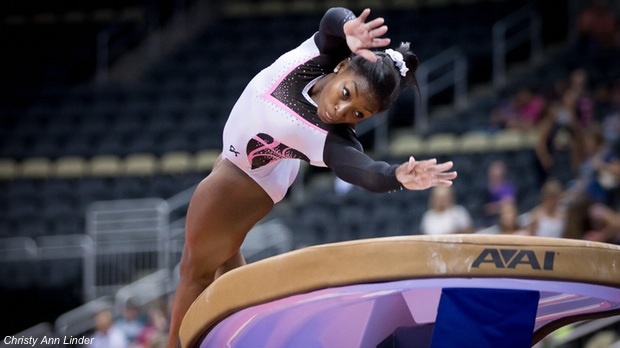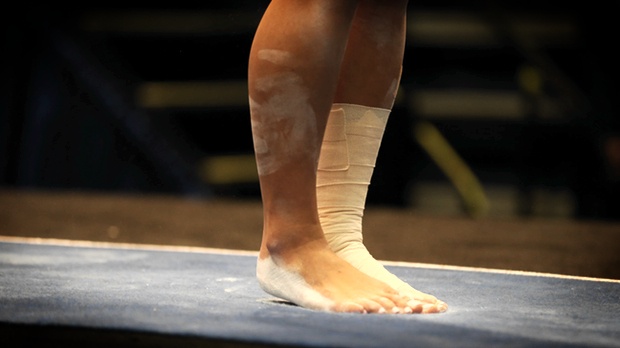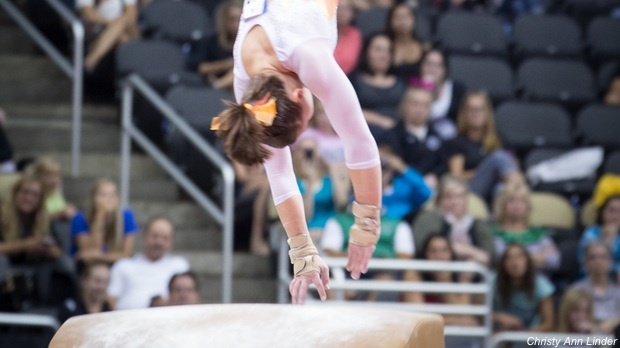Elite Vaulting - the D-Score Explained
Elite Vaulting - the D-Score Explained
Elite Vaulting - the D-Score Explained


In our final installment on understanding the D-score in elite gymnastics, we are taking a look at the vault. The vault is unique in that the gymnast performs one move which accounts for the entire D-score. That being said, there are several different types of vaults that elite gymnasts can perform, in addition to a few rules that must be adhered to for vault finals on the international stage.
First, it’s important to understand the five major vault groups, as defined by the Code of Points (CoP). Gymnasts competing in the vault finals at the World Championships or Olympics are required to perform two vaults from different vault groups and with different 2nd flight phases. The various vault families are explained below.
Group 1 vaults include vaults without saltos, with or without a turn in either flight phase. This type of vault will rarely, if at all, be seen in elite gymnastics today because of the low difficulty score attached. The highest D-score a gymnast can achieve if performing a vault from Group 1 is a 4.5 - a handspring on and 2 ½ turn off. It would be tough for an elite gymnast to even make vault finals with such a low D-score.
Group 2 vaults include those with a handspring forward on (with or without a full turn), and a salto either forward or backward off (with or without turn). These days, the most popular vault competed in this group is the front handspring on, 1 ½ twisting salto off, worth 6.2. At the World Championship vault finals in 2014, three gymnasts competed this vault (the only vault competed from Group 2) - Giulia Steingruber (Switzerland), Alexa Moreno Modena (Mexico) and Thi Ha Phanh Phanh (Vietnam). The other notable vault in this family is the Produnova, a front handspring on with two front somersaults off (worth 7.0), which Yamilet Pena of the Dominican Republic has attempted with varying success in previous years.

Group 3 vaults involve a front handspring on with ¼ - ½ turn in the 1st flight phase (known as Tsukahara) and a salto backward, with or without turn, on the 2nd flight phase. Interestingly, no gymnast competed a vault from this family at the 2014 World Championship vault finals, and only one gymnast (Oksana Chusovitina of Germany) competed one at the 2013 World Championship vault finals, when she performed a Tsukahara stretched with 1 ½ twist (worth 5.5). Elena Zamolodchikova of Russia was known for this vaulting style, having the laid out double twisting Tsukahara named after her.
By far the most popular vault family these days is Group 4 in the CoP - a round-off (Yurchenko) with or without ¾ turn in 1st flight phase and a salto backward with or without a turn in the 2nd flight phase. The Amanar (6.3 value), performed frequently on the world stage lately, particularly by the Americans, belongs in this vault group, as do other lesser-value Yurchenko-style vaults, such as the Yurchenko with double twist (5.8 value). The lowest value Yurchenko vault competed recently on the world stage was at the 2014 Worlds vault finals, when Giulia Steingruber competed a Yurchenko with full twist (5.0 value).

Lastly, Group 5 vaults consist of another round-off entry, but with a ½ turn in the 1st flight phase, and a salto backward or forward in the 2nd flight phase. Gymnasts who compete a vault from Group 4 as one of their vaults in vault finals will often compete a vault from Group 5 as their second vault. Examples of this type of vault include the Cheng (round-off with ½ turn on, stretched salto forward with 1 ½ turn off), worth a high 6.4 and competed in the past two years by Hong Un Jong (North Korea), MyKayla Skinner (USA) and Alla Sosnitskaya (Russia). Two other vaults in this family have been performed by elite gymnasts recently - the laid-out Podkopayeva (Round-off with ½ turn on, salto forward with ½ turn off), worth 5.6 and competed by Simone Biles, and the Mustafina (Round-off, half-on, front layout with full twist off), worth 6.0 and competed by McKayla Maroney.
Now that you know all about the different vault groups, how has the popularity of certain vaults changed over the years? Although the vaults performed have certainly gotten more difficult over the years, the preferred styles have not changed much. At the 2004, 2008 and 2012 Olympics, the round-off with either back or half-on entry (Groups 4 and 5 in the CoP) were the most commonly performed vaults. In 2000, the Tsukahara was much more common, being performed about as often as the Yurchenko style, but the Yurchenko has still seemed to dominate the elite stage for the past several decades.
This concludes our 4 part series on the D-score in elite gymnastics - we hope it’s been useful!
Related:
Crafting a Bars Routine: An Analysis of the D-Score
Crafting a Floor Routine: An Analysis of the D-Score
Crafting a Beam Routine: An Analysis of the D-Score